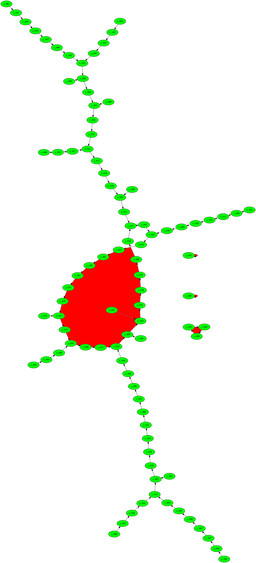
My latest posts can be found here: Previous blog posts:
Additionally, some earlier writings: |
Pollard Rho in briefThe basic idea is that we have a number $N$ to factor, and we've already stripped out all the really small factors by using a quick hit of trial division[1]. Now what we do is run around the integers modulo N and hope to get a coincidence. So we have $N$ and we assume that there is some $p,$ currently unknown to us, which divides $N.$ We're trying to find $p.$ We define a sequence $\{x_i\}_{i=0}^\infty$ with $x_0$ something a bit arbitrary, and $x_{i+1}=x_i^2+c$ for some $c,$ often just a small integer from 1 to 5 or so. We compute the sequence modulo $N,$ but thinking about it modulo $p$ we can see that it must eventually start repeating. So after some values that don't get repeated we end up in a cycle (mod $p$). So at some point $x_i=x_j\ (mod p)$ and we can detect this by computing $gcd(x_j-x_i,N)$ and finding that it's bigger than 1. The AlgorithmSo the algorithm is:
def f(x): x^2 + c
x_0 = k:
rabbit = x_0
turtle = x_0
while True:
rabbit = f(f(rabbit))
turtle = f(turtle)
g = gcd(rabbit-turtle,N)
if 1 < g <=N:
return g
Why it worksSo how and why does this work? Thinking about the sequence ${x}$ mod $p$ we can see that it eventually cycles. Each term is the square of the one before, plus a constant, so we can think of the values as "pinging about randomly," and because of the birthday paradox says we should get a repeat time $O(\sqrt{p}).$ So if $p$ isn't too big we should find it reasonably quickly, and in any rate in time $O(n^{\frac{1}{4}}).$ And now for something completely differentSo why do we use $f(x)=x^2+c$ ? Is there something special about that? If we have any pseudo-random $f:Z_p -> Z_p$ then we'd think that would work. So we plot the digraph with nodes for integers and edges for $a$ goes to $b,$ the digraph we get for the quadratic shows that there are lots of cycles that aren't too large, and the paths that take you into the cycles are not very long. On the other hand, the first quick hack I tried for a pseudo-random thingy either has very long tails before we get to a cycle, or has very long cycles.
I don't understand this. True, I've only drawn digraphs for comparatively small $N,$ because I don't have the tools immediately to hand to layout huge graphs. But even so, there's something going on here that I don't understand. I suspect there's something going on with the fact that $x^2+c$ is such that every node has out degree 1, but in degree either 0 or 2 (with a couple of possible exceptions). That might have something to do with the overall structure, but I don't see how that's critical. And if it is critical, then perhaps we can make a pseudo-random function that has the right properties, but is faster than computing the square each time. It's not a huge speed-up, but it might be worth having. And if it is the degree structure that matters, perhaps we can devise one that's fast to compute and even more favourable. As I say, idle musings ...
References[0] https://en.wikipedia.org/wiki/Pollard%27s_rho_algorithm [1] https://en.wikipedia.org/wiki/Trial_division
Send us a comment ...
|




 Suggest a change ( <--
What does this mean?) /
Send me email
Suggest a change ( <--
What does this mean?) /
Send me email